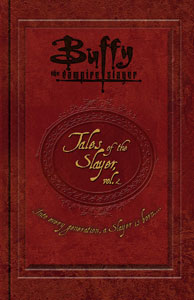Drawing a better overall crop of writers, “Tales of the Slayer, Vol. 2” (January 2003) makes a huge jump in quality from the first volume. The authors have a blast playing with our expectations of how Slayers, Watchers and vampires should behave while using familiar Buffyverse beats to teach us about societies throughout human history. Here are my rankings of the 10 stories:
1. “The War Between the States” (New York City, 1922) by Rebecca Rand Kirshner – “Buffy” TV writer Kirshner delivers the volume’s masterpiece, writing from the perspective of Sally Jean, a “soft” Southern Belle (indeed, everyone admires her softness) who aims to reinvent herself in the Big Apple. Words and phrases from the era, and details such as clothing styles, give us a sense of time and place and Sally Jean’s worldview. Sally Jean is selfish, and the way she casually crushes fiancé Brett’s heart is striking, but we’re pulled into her increasingly wild life. This is a rare tale where the Slayer is a side character, and maybe that’s a cheat, but this story is so good that I forgive it.
2. “Stakeout on Rush Street” (Chicago, 1943) by Max Allan Collins with Matthew V. Clemens – Collins has also done tie-in fiction for “The X-Files” and “Dark Angel,” but his biggest strength is writing in the hardboiled detective genre, and it’s a blast to see him blend a first-person noir style with a Slayer tale. When her husband is away at war, Elizabeth balances her detective agency with Slaying. Of one vamp, she says “his breath (was) strong enough to kill, even if he never laid a pearly white on my neck.” “Stakeout” is filled with such wonderfully evocative phrases.
3. “Again” (Sunnydale, 1999) by Jane Espenson – The “Buffy” TV writer pens a tale of Buffy being transported from Season 6 into her high school self, five years before the comics would do the same thing in Season 8, Issue 20. The comic is lightly nostalgic, whereas this short story is a lump-in-your-throat character piece that gives us a taste of what it was like for Buffy when she was in Heaven between Seasons 5 and 6, as she gets a second chance to spend time with her mom. Xander and Willow are also on this journey, allowing for their personal reflections on how they’ve changed in three short years, which at that age can seem long. Espenson wraps the tale in a nice bow with the revelation of the culprits behind the time-jump.
4. “House of the Vampire” (London, 1897) by Michael Reaves – The animation and “Star Wars” Legends scribe reveals that Buffy isn’t the first Slayer to have friends fighting at her side. In the waning days of Victorian London, Angelique likewise avails herself of allies, but it doesn’t work out so well for her. For one, her Watcher (Peter Van Helsing, the brother of the more famous Abraham) is less forgiving of this protocol breach than Giles; for another, she faces Dracula, who knows how to use pawns to win a chess match. In another surprising (and probably accidental) continuity touch, Angelique faces Springheel Jack, who also appears in “The Gatekeeper Trilogy.”

5. “The New Watcher” (Atlanta, 1864) by Kristine Kathryn Rusch – In “Buffyverse” historical fiction set during wartime, you can bet that vampires played a role on the side that history has looked down upon (see “Angel: Blood & Trenches” and “Spike vs. Dracula”). This Civil War-set yarn is no exception, as we learn bloodsuckers fight for the Confederacy. Rusch gives a compelling, if uncomfortably forgiving, characterization of the Union’s General Sherman, who is famous for burning down Atlanta. Frankie is one of two Slayers in this book to pose as male in order do her duty, and Rusch wrings tension from her worry of being found out.
6. “The Ghosts of Slayers Past” (London, 1843) by Scott Allie – Allie, the editor and sometimes writer of Dark Horse’s “Buffy” comics, delivers an effective riff on “A Christmas Carol.” Watcher Charlton Muzzlewit sees his Slayer, Catherine, as a mere weapon to be used, until he’s visited by Slayers in his dreams – including a cool cameo. Above all, though, this is a striking portrayal of the squalor of the lower class neighborhoods in mid-19th century London, where Catherine lives.
7. “Blood and Brine” (The Caribbean, 1661) by Greg Cox – Fans of pirate fiction will be delighted by the pirate Slayer named Robin, who disguises herself as a man in order to retain her station. While Cox telegraphs the culprit, there’s still a lot of high-seas tension as Robin must deal with the supernatural threat along with mutineers among her own crew. And the monster is an inventive one: a giant demon squid (literally a demon, in this case).
8. “Abomination” (France, 1320) by Laura J. Burns and Melinda Metz – The “Roswell High” authors deliver a harrowing story that borders on misery porn as Elaine faces enemies from all corners. While the vampires that tear through her nearby village are frightening enough, scarier still might be the Council operative who hauls away her Watcher/lover, since their relationship is against the rules. Elaine – who also has two children to protect — refuses to fight until Michel is returned to her, and she’s torn up by the decision the whole time.
9. “Lady Shobu” (Japan, 980) by Kara Dalkey – A lot of these tales show how tough it is for past Slayers to navigate societies where women are subservient, and this is the most extreme. The Council doesn’t even allow Shobu to bring weapons into her undercover role as the queen’s protector. It’s especially disheartening at the end when we learn who Shobu’s new Watcher is, and that this person could’ve been a source of help, rather than only caring about testing the Slayer.
10. “All That You Do Comes Back Unto Thee” (Sunnydale, Calif., 2000) by Todd A. McIntosh – The book starts off with a YA-style entry from the legendary “Buffy” makeup artist. I find it hard to believe that a student, other than those we know from the TV series, was doing spells with Willow at Sunnydale High. I suppose it’s plausible. But it’s obvious where this Season 4-set yarn is going: It’s a lesson about the consequences of doing spells without the proper protections (insert your own metaphor).
Click here for an index of all of John’s “Buffy” and “Angel” reviews.

